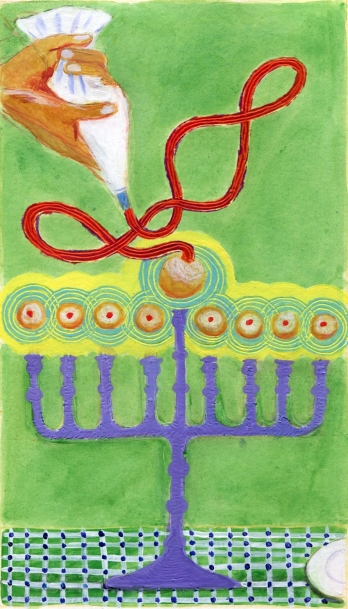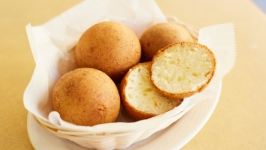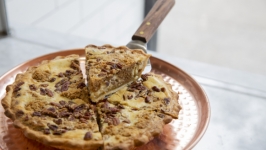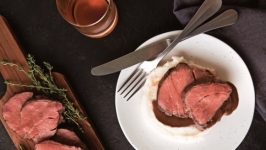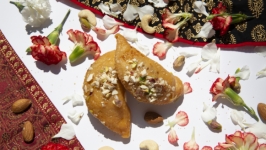The Miracle of Oil, Jelly-filled and Sugar-Rolled
Growing up, my first-generation American, secular Ashkenazi family observed the major Jewish holidays, especially those registering high on the established culinary traditions scale. We feasted on Rosh Hashanah with apples and honey before long, festive meals punctuated with Grandma’s traditional German apple cake. At Passover seders we ate her famous “sinker” matzo balls along with gefilte fish, roughly chopped Ashkenazi charoset and of course, matzoh.
Yom Kippur was the one large holiday meal not celebrated around my grandmother’s table, and instead we hosted breakfast at our house with an elaborate appetizing spread, our kitchen counters piled high with bagels, lox, pickled herring and smoked fish.
As in many American Jewish families, our gastronomic expression of Chanukah’s miracle of oil was latkes. Sometimes we made latkes from scratch, sometimes we bought them from a store or restaurant, but come Chanukah, we always ate latkes. And why not? Latkes are a perfect fried-in-oil wonder with their crispy outside and pillowy inside.
If it was just latkes, it would have been enough—Dayenu! Imagine my surprise when I learned, well into adulthood, that there is another traditional Chanukah food that embraces the fried-in-oil ethos and that this other food is a doughnut! I felt robbed! How many years of doughnuts had I missed? Too many to adequately mourn. So instead of wallowing, I decided to make doughnuts an integral part of my annual oily celebration of Chanukah from that moment forward.
For the past few Chanukahs, I have made doughnuts with my child, and they’ve revealed themselves to be the best combination of impressive and yet easy to make. Traditional Chanukah doughnuts, called sufganiyot, are jelly-filled and rolled in powdered sugar. There is no reason not to love making or eating them. The kitchen tools used to inject the jelly into the donut are a joy to operate for adults and children alike, and surgical precision isn’t necessary, since even with jelly oozing from the side or top, it’s still a doughnut, and it’s still delicious.
I’ve given myself an A+ on Chanukah parenting, since my child won’t grow up resenting me for keeping him from an annual week-long excuse to feast on doughnuts.
With my childhood’s latke and my adulthood’s sufganiyot, I’ve built my family’s complete, balanced Chanukah meal. Learning about and then embracing sufganiyot as an adult has coincided with an exploration of my roots through the vast culinary landscape of Jewish foods.
My family’s holiday menus are deliciously expanding as I reach out beyond the predictable Jewish food greatest hits of my youth. It’s here, beyond the borders of bagels and jarred gefilte fish, that I found sufganiyot, as well as a weekly ritual of baking homemade challah, adding Yemeni charoset to our Passover Seder and making Moroccan salads at every opportunity. I’ve learned that the richness of traditional Jewish foods is virtually endless, and just as varied as the people who make up the Jewish diaspora on every corner of this planet


